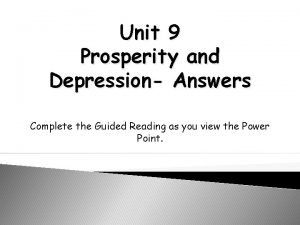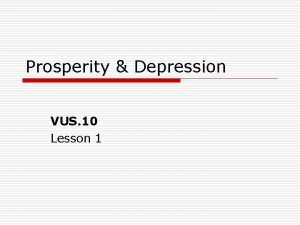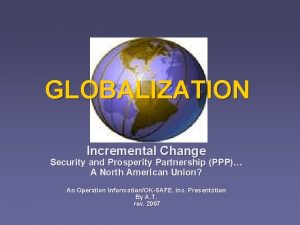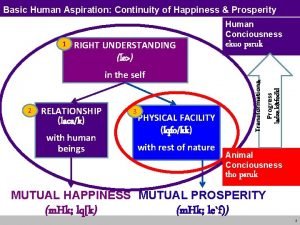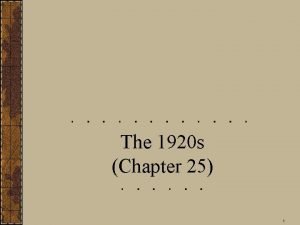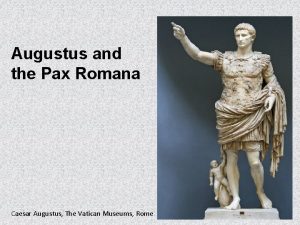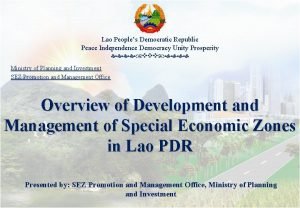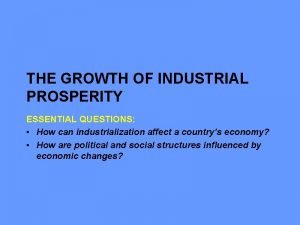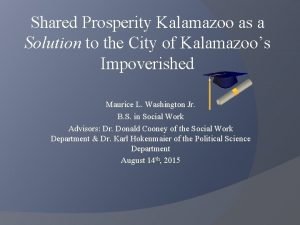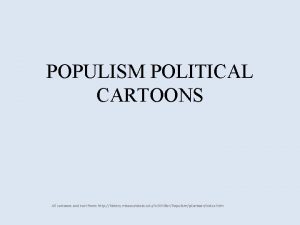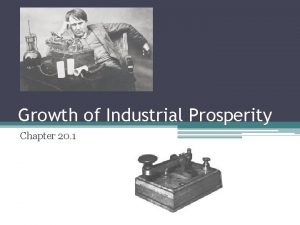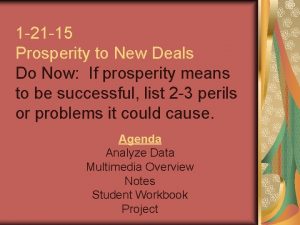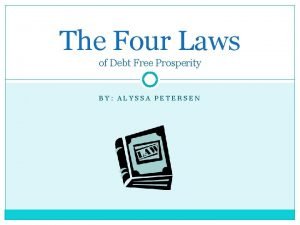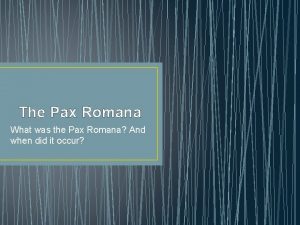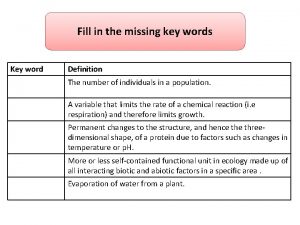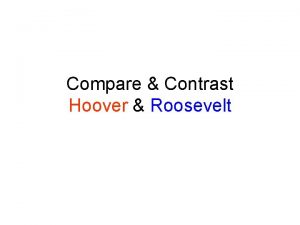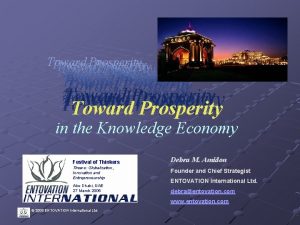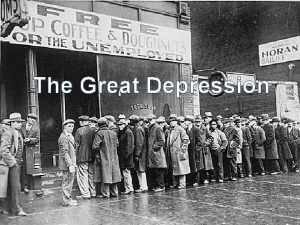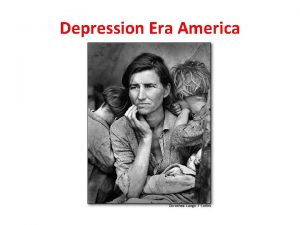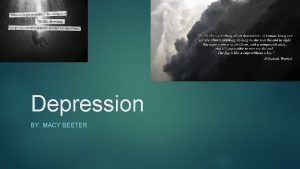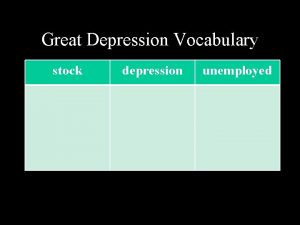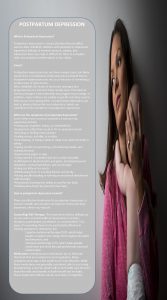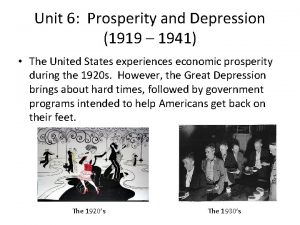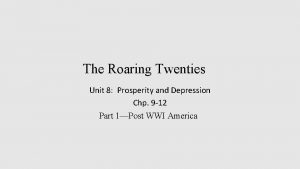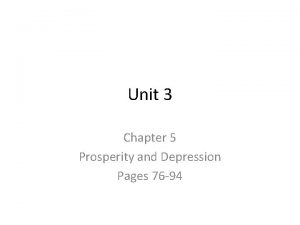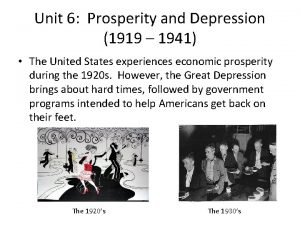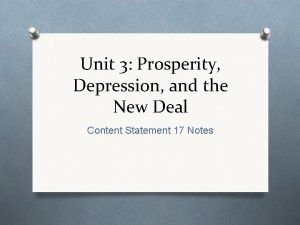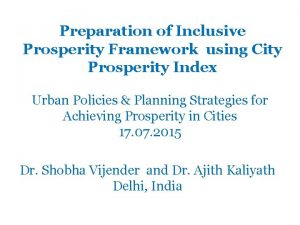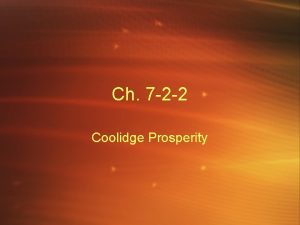Unit 9 Prosperity and Depression Answers Complete the



































































- Slides: 67

Unit 9 Prosperity and Depression- Answers Complete the Guided Reading as you view the Power Point.

Unit 9: � Objective 9. 01: Elaborate on the cycle of economic boom and bust in the 1920 s and 1930 s. � Essential Questions: � • How did the economic, social, and political events of the early 1900 s lead to the economic cycles of the twenties and thirties? � • How did the variations in the economy in the 1920 s cause major changes in that decade and in the 1930 s? � • How did early government reactions to the economic bust serve to worsen its effects?

Economic Cycles of the 1920’s and 30’s

Warren G. Harding and the Return to Normalcy: � In the 1920’s people in America wanted to return to the security they felt before WWI � Warren G. Harding was elected president in 1920 � Harding campaigned on a belief that America needed to “Return to Normalcy” � Return to Normalcy: a return to isolationism, less social reform, and increased economic growth � Harding was popular due to a foreign policy of isolationism and a domestic economic growth

Warren G. Harding and the Return to Normalcy: � In 1923 Harding’s presidency was shaken by scandal � Teapot Dome Scandal: Harding’s Secretary of the Interior, Albert Fall, took $300, 000 in bribes to allow oil companies drill in California and Teapot Dome , Wyoming � Harding died a few months later- many believe the stress killed him � Albert fall went to jail

Coolidge Supports Laissez-Faire Economics: � After Harding’s death Calvin Coolidge became president � Coolidge supported laissez-faire economics and big business � Coolidge said “The business of the American people is business” � He believed the government should stay out of business and that a natural business cycle would fix any economic problems

Coolidge Supports Laissez-Faire Economics: � For most of the 1920’s Coolidge was right � The economy did very well � People made money and many people were successful in the stock market (a place to invest money) � People bought stocks on speculation: making high risk investments in hopes of making big profits � Some risk takers invested through a system called buying on margin: purchasing stocks for a portion of their value and taking out a loan to pay the difference � They believed the stock market was doing so well they could make money while paying off the loan

Coolidge Supports Laissez-Faire Economics: � Advances in technology helped increase the economy � Henry Ford’s assembly line changed how companies produced their products � Mechanization: increased use of machinery for production � Why is it important? � Companies could make products faster and cheaper so more people could buy them- when people spend money companies make money and can hire more people to work- everyone wins

Farmers in the 1920’s: � Farmers were one group of people that did not do well in the booming economy � During WWI farmers did well because their products were needed to support the country and the soldiers over seas � After WWI new technology helped farmers produce more � The increase in production caused prices to drop and farmers lost money � Buying new technology created debt for farmers � President Coolidge did nothing to help farmers

Hoover and the Beginning of the Great Depression: � Herbert Hoover became president in 1929 � He too believed in laissez-faire economics � October 29, 1929: Black Tuesday: the stock market crashed � Prices dropped drastically � Many who bought stocks on speculation or through buying on margin lost everything � Banks and stock brokers called in loans that people couldn’t pay back � Why is it important? � It was the beginning of the Great Depression

Hoover and the Beginning of the Great Depression: � Hoover thought the economy would fix itself so he didn’t do much to fix the problem � Things got worse over time � Hoover tried to support U. S. business with the Hawley-Smoot Tariff, but it turned out to be a disaster- European countries raised their tariffs and international trade slowed

Rugged Individualism Verses Direct Relief: � People’s opinions of government changed during the Depression � Before the fall people saw the U. S. as a place where people depended on their own rugged individualism: you take care of yourself and your family � People believed with hard work and devotion anyone could be a success � People saw government’s role as one to uphold laws and protect freedom

Rugged Individualism Verses Direct Relief: � Why is it important? � With the Depression people believed rugged individualism was not enough � People felt the nations' government should provide direct relief: helping those who could not provide for themselves due to the economic crisis � They now wanted government to provide security, protect freedom, and provide economic security

Unit 9: � Objective 9. 02: Analyze the extent of prosperity for different segments of society during this period. � Essential Questions: � • How were different groups of people affected by the business cycles of the 1920 s and 1930 s? � • How do economic changes impact society? � • Why and how does economic prosperity vary so much from one segment of society to the next?

From Prosperity to Depression

The Rise of Consumerism in the 1920’s: � Before the Depression, the advertising industry grew in America � Advertisers used the radio, movies, and magazines to convince people to use their money to buy certain products � Advertisers convinced people that they not only wanted these products but that they needed them as well

The Rise of Consumerism in the 1920’s: � Installment plans were invented: producers gave consumers easy credit that allowed customers to pay a little at the time instead of all at once (similar to layaway, taking out a car loan, rent to own, etc. ) � People bought expensive items like cars and refrigerators � Sales increased � Why is it important? � America became a consumer society where most people were buying � People no longer focused on saving money � Social status was measured by the amount you could buy � The economy grew � DEBT grew as people’s savings decreased!!!

Overproduction: � People were buying more products, but they still could not afford to buy them at the fast rate that they were being produced � Overproduction: when too much of certain products are produced- too much supply causes prices to fall � Warehouses were full of overstocked itemsthis was a sign that the good times of the 1920’s might not last forever, but no one paid attention

Overproduction: � Farmers overproduced too � During WWI farmers stripped the land in the Midwest and left it damaged by poor farming techniques as they worked to meet the high demand for food for America and soldiers � They Midwest also suffered a massive drought that dried up the land turned the soli to dust � Dust Bowl: a series of storms that hit the Midwest that blew up enormous clouds of dust � Dust covered cities, towns, farm fields, destroyed areas and left them unlivable

Overproduction: � Why is it important? � Hundreds of thousands of people were homeless or displaced � Many people moved to California thinking it was a land of promise where they could start new � John Steinbeck wrote “The Grapes of Wrath” about a family that moved out of the Dust Bowl to California looking for new opportunities � Photographer Dorothea Lang became famous for her work documenting the victims of the Dust Bowl while she worked for the federal Farm Security Administration

Discovery Education Videos: � Dust Bowl � Images

The Great Depression Hits: � The stock market crash made the economy fall apart � People rushed to banks and withdrew their money � This high number of withdrawals caused banks to close due to lack of money � People no longer trusted the stock market and stopped investing in it- this caused stock prices to fall even lower � Wealthy people all of a sudden found themselves with nothing � At one point more than ¼ of the country was out of work � Many thousands of people were homeless

The Great Depression Hits: � People had to rely on soup kitchens and breadlines for food � Homeless people gathered together and lived in shacks in little villages called “Hoovervilles” – because they blamed President Hoover for much of the Depression � 1932 Bonus Army March: WWI veterans marched to Washington D. C. and demanded payment of a bonus that had been approved in 1924, but was not to be paid until the 1940’s

The Great Depression Hits: � Why is it important? � The veterans camped in Hoovervilles while they waited for Congress to debate the issue � When Congress refused to give the bonus early the veterans refused to leave � President Hoover used federal troops to have the veterans removed � Several protesters including women and children were killed and injured � The event made people angry with President Hoover

Discovery Education Videos: � Great Depression

Unit 9: � Objective 9. 03: Analyze the significance of social, intellectual and technological changes of lifestyle in the United States. � Essential Questions: � • How do technological and social changes impact American traditions? � • To what extent should the federal government attempt to effect economic and social change? � • What should the role of the federal government be in the economic and social lives of its citizens? � • What long term effects did the New Deal have on the United States?

Social, Intellectual, and Technological Changes of the Period

New Technology: � Many new inventions became important in the 1920’s and 1930’s � Radio: used for entertainment and communication � People across the country could enjoy the same shows and hear the same news reports � Political leaders could not reach more people and share their ideas and policies � Franklin D. Roosevelt benefited from the use of radio as a politician

New Technology: � As president Roosevelt used the radio to broadcast a series of fireside chats to directly communicate with Americans � This close communication gave Americans a sense of security and confidence as they heard the president's voice directly even as they continued to suffer tough economic times

New Technology: � During the 1920’s transportation changed � More people could afford cars � People were mobile than ever beforethey could travel more often and farther than they could when forced to walk everywhere � Airplanes allowed people to travel faster and more efficiently � Charles Lindbergh was a famous pilot- first person to fly solo and non-stop across the Atlantic Ocean by flying from the U. S, to Paris, France

New Technology: � The Movie Industry grew from silent films to talking pictures called talkies � 1927 The Jazz Singer was the first film to ever feature sound- starring singer Al Jolson � Fashions and lifestyles in movies helped to define our national culture � For the first time in our nation we idolized movie stars- we wanted to be like them, have what they had, and live like them

Discovery Education Videos: � Lindbergh Baby Kidnapping

Social Behavior: � People began to enjoy spectator sports during the 1920’s- they began to like to watch professionals play sports � Jack Dempsey: boxing heavyweight champion of the world � Babe Ruth: famous baseball player- played for the New York Yankees and then traded to the Boston Red Socks � Jazz became a popular form of music after WWI as African American musicians moved from New Orleans and Mississippi to the North � Louis Armstrong: famous jazz musician from New Orleans

Discovery Education Videos: � Entertainment in the 1920’s and 1930’s

Speakeasies and Bootleggers: � 1919 the 18 th Amendment outlawed alcohol � Bootleggers: criminals who sold illegal alcohol � Their name came from the old trick of drinkers hiding flasks in their boots � Speakeasies: illegal bars during prohibition � Organize crime grew as gangsters controlled bootlegging and speakeasies � Al Capone: famous gangster

Discovery Education Videos: � Al Capone- Gangsters � Prohibition

Intellectual Trends: � Most people loved to spend, spend during the 1920’s � Others didn’t see it as a good thing � They saw consumerism and materialism as destructive � Consumerism: buying what you want even if you have to go into debt � Materialism: craving material possessions � Many writers criticized this behavior by the American public

Intellectual Trends: � Langston Hughes: African American writer of poetry and short stories about the African American experience- reminded African American of their heritage � Sinclair Lewis: famous writer- first to win Nobel Prize for Literature � The Lost generation: group of writers that felt lost in society with so much greed and moral corruption ◦ F. Scott Fitzgerald: wrote The Great Gatsby ◦ Ernest Hemingway: wrote The Sun Also Rises

Unit 9: � Objective 9. 04: Describe challenges to traditional practices in religion, race, and gender. � Essential Questions: � • How were government programs in the 1920 s and 30 s a challenge to traditional practices in religion, race, and gender? � • How does conflict promote change in a nation’s identity? � • To what degree did America experience social progress during the 1920 s and 30 s? � • How was America changed the 1920 s and 30 s?

Race, Religion, and the Role of Women

African Americans and the Issue of Race: � During the early 1900’s many African Americans began to support the black community and speak out for equality � W. E. B. Du Bois: began Niagara Movement and NAACP � Marcus Garvey: began the Universal Negro Improvement Association and Back to Africa Movement � 1920’s Harlem, New York African Americans wrote in support of racial pride

African Americans and the Issue of Race: � Why is it important? � The Harlem Renaissance began � Period in time when black painters, dancers, writers, musicians produced great works of art � Zora Neal Hurston: wrote Their Eyes Were Watching God

Changes and Controversy Surrounding Women: � During the early 1900’s more and more women began to work outside of the home because of advances in technology and the need for money to support their families � Women worked as secretaries, and telephone operators � Women faced many obstacles � Usually single women were hired because men believed married women would get pregnant and quit � There was no such thing as maternity leave so most times women did have to quit when they had a baby � Women were rarely given leadership roles in business

� As Changes and Controversy Surrounding Women: more women began to work they changed their clothing and hair styles � Popular hair style called the ear bob- hair cut to the length of the ears � Women began to go out on dates alone in public without a chaperone � These new women were called Flappers because they seemed to be more fun-loving and outgoing than women of the past � Many traditional men and women looked down on flappers and their new ideas

Margaret Sanger and the Women’s Movement: � Margaret Sanger: New York City nurse believed large families led to poverty and limited the opportunities of women � Led a campaign to spread information about birth control � Believed in eugenics- idea that the human race should be improved through controlled selective breeding � Viewed nation’s minority population as a source of poverty and thought it was growing too quickly � Usually located her birth control clinics in minority areas � Why is it important? � She began American Birth Control league- now called Planned Parenthood

Margaret Sanger and the Women’s Movement: � 1920 the 19 th Amendment gave women the right to vote � Many people opposed women's suffrage because they feared it would challenge traditional gender roles between men and women

Discovery Education Videos: � 19 th amendment

The Issue of Religion: � Many people of religion felt scientific discoveries challenged their beliefs � Others looked at destruction such as WWI and questioned the existence of God � During this time a Fundamentalist movement began � They believe that the Bible is literally true and because it is from God it cannot contain contradictions or errors � Billy Sunday: famous fundamentalist preacher � Aimee Semple Mc. Pherson: preached fundamentalist beliefs on the radio

The Scopes Trial: � 1925 Scopes Trial: Science teacher John Scopes was arrested for teaching Darwin's Theory of Evolution instead of the Bible’s story of creation � This violated Tennessee law � William Jennings Bryan prosecuted the trial � Clarence Darrow defended Scopes � Darrow put Bryan on the witness stand under oath he admitted even he did not literally believe everything in the Bible � Scopes lost and the Tennessee law remained

Unit 9: � Objective 9. 05: Assess the impact of the New Deal reforms in enlarging the role of the federal government in American life. � Essential Questions: � • How did the role of the federal government change during the 1920 s ands 30 s? � • Is it appropriate for the government to be involved in social and economic change? � • To what degree did America change positively or negatively during the 1920 s and 30 s? � • Why did citizens allow the federal government to increase its power during the Great Depression, and how did it impact the future of the � nation?

F. D. R. and the New Deal

Franklin Delano Roosevelt: � Elected President in 1932 � Represented hope for a better future to much of the nation � Known as FDR � FDR was willing to try to use the government to help relieve the Great Depression � Roosevelt’s Brain Trust: a group of smart people and experts who advised FDR about how to help fix the economy � Frances Perkins: first female Secretary of Labor ◦ Helped write minimum wage laws ◦ Helped win passage of the Social Security Act

The New Deal: � FDR believed the government should provide direct relief to the people of the U. S. � Those who disagreed told him to leave the economy alone and let it fix itself � FDR took a risk and began to use deficit spending: when the government spends borrowed money (going into debt) � The New Deal: government programs and legislation intended to provide relief, jobs, economic recovery, and help to Americans � During the first hundred days of FDR’s administration he worked to pushed the New Deal through Congress

New Deal Programs: � Civilian Conservation Corps: employed unmarried men between ages 17 – 23 � Worked in national parks installing electric lines, building fire towers, planting new trees � Government provided many of their basic needs � Able to send money home to support their families

New Deal Programs: � Federal Deposit Insurance Program: insured bank deposits up to $100, 000 in case of bank failure � Intended to stop people from rushing to the banks and withdrawing money in the event of another crisis

New Deal Programs: � National Industrial Recovery Act: created to support industrial prices and prevent business from failing

New Deal Programs: � Agricultural Adjustment Act: government gave loans to farmers � Paid them not to grow certain crops to prevent overproduction � Many didn’t like the policy because so many people were still without food

New Deal Programs: � Tennessee Valley Authority (TVA): built hydroelectric dams to create jobs and bring cheap electricity to parts of the South that didn’t have power � Helped the southern Appalachian mountain region prosper

New Deal Programs: � Public Works Administration: provided jobs by building dams, highways, and bridges

New Deal Programs: � Securities and Exchange Commission (SEC): created to prevent excessive stock market speculation � Limited buying on margin practices � Established rules requiring corporations have clear and honest accounts of their financial status

New Deal Programs: � Social Security Act: provides retirement income for all workers at age 65

New Deal Programs: � National Labor Relations Act: Wagner Act: created aboard to monitor unfair management practices- like firing workers who join unions

New Deal Programs: � Works Progress Administration: provided jobs for unskilled workers � Constructed many government buildings �

New Deal Programs: � Fair Labor Standards Act: raised minimum wage to. 40 cents an hour � Set maximum work hours at 44 per week � Ended child labor under age 16

Critics of the New Deal and the Court Packing Scheme: � Not everyone loved the New Deal � Many thought it gave government too much power over business � Others thought more changes were needed � Father Charles Coughlin: Catholic priest who believed in nationalization (government ownership) and redistribution of wealth (taking money from the rich and sharing among the whole population) � Had a radio show where he discussed his political view about the government and religious views against the Jewish religion � Indicted by a Grand Jury under the Espionage Act in 1942 for speaking against the president

Critics of the New Deal and the Court Packing Scheme: � Huey P. Long: senator from Louisiana � When he was governor of Louisiana he was a boss of a political machine � He fought for the poor and the underprivileged � Supported the redistribution of wealth � He wanted to give every U. S. family $2, 000 a year � Wanted to limit the income to any U. S. citizen to $1 million a year- the government would take the rest in taxes � Killed by the son-in-law of one of his political enemies in Baton Rouge, Louisiana

Critics of the New Deal and the Court Packing Scheme: � The Supreme Court struck down many of FDR’s New Deal ideas � 1937 FDR proposed a Court Packing Scheme: wanted to add more judges to the Supreme Court to fill the Court with judges who supported his New Deal programs � Angry opposition forced FDR to withdraw his court packing plan � Many parts of his New Deal passed and were very successful
 Prosperity and depression worksheet answers
Prosperity and depression worksheet answers Prosperity and depression worksheet answers
Prosperity and depression worksheet answers 8-5 angles of elevation and depression answers
8-5 angles of elevation and depression answers Postwar prosperity and civil rights
Postwar prosperity and civil rights Basic human aspirations and their fulfillment
Basic human aspirations and their fulfillment Mexiplex
Mexiplex What is basic human aspiration
What is basic human aspiration Chapter 14 postwar prosperity and civil rights
Chapter 14 postwar prosperity and civil rights Pax romana prosperity and stability
Pax romana prosperity and stability Simple subject and complete subject
Simple subject and complete subject Aaa new deal logo
Aaa new deal logo Prosperity oil
Prosperity oil Mascot international (lao) sole co. ltd
Mascot international (lao) sole co. ltd The growth of industrial prosperity
The growth of industrial prosperity Shared prosperity kalamazoo
Shared prosperity kalamazoo Populist party political cartoon
Populist party political cartoon The growth of industrial prosperity
The growth of industrial prosperity Prosperity deals
Prosperity deals The four laws of financial prosperity
The four laws of financial prosperity Simplicity is prosperity
Simplicity is prosperity Phases of a business cycle
Phases of a business cycle What year did the pax romana begin
What year did the pax romana begin People planet prosperity
People planet prosperity Buy life
Buy life Epsrc prosperity partnerships
Epsrc prosperity partnerships Unit 6 review questions
Unit 6 review questions Bacterial growth
Bacterial growth Hoover and fdr compare and contrast
Hoover and fdr compare and contrast Hình ảnh bộ gõ cơ thể búng tay
Hình ảnh bộ gõ cơ thể búng tay Lp html
Lp html Bổ thể
Bổ thể Tỉ lệ cơ thể trẻ em
Tỉ lệ cơ thể trẻ em Gấu đi như thế nào
Gấu đi như thế nào Glasgow thang điểm
Glasgow thang điểm Chúa sống lại
Chúa sống lại Các môn thể thao bắt đầu bằng tiếng nhảy
Các môn thể thao bắt đầu bằng tiếng nhảy Thế nào là hệ số cao nhất
Thế nào là hệ số cao nhất Các châu lục và đại dương trên thế giới
Các châu lục và đại dương trên thế giới Công thức tiính động năng
Công thức tiính động năng Trời xanh đây là của chúng ta thể thơ
Trời xanh đây là của chúng ta thể thơ Cách giải mật thư tọa độ
Cách giải mật thư tọa độ Làm thế nào để 102-1=99
Làm thế nào để 102-1=99 độ dài liên kết
độ dài liên kết Các châu lục và đại dương trên thế giới
Các châu lục và đại dương trên thế giới Thơ thất ngôn tứ tuyệt đường luật
Thơ thất ngôn tứ tuyệt đường luật Quá trình desamine hóa có thể tạo ra
Quá trình desamine hóa có thể tạo ra Một số thể thơ truyền thống
Một số thể thơ truyền thống Cái miệng bé xinh thế chỉ nói điều hay thôi
Cái miệng bé xinh thế chỉ nói điều hay thôi Vẽ hình chiếu vuông góc của vật thể sau
Vẽ hình chiếu vuông góc của vật thể sau Nguyên nhân của sự mỏi cơ sinh 8
Nguyên nhân của sự mỏi cơ sinh 8 đặc điểm cơ thể của người tối cổ
đặc điểm cơ thể của người tối cổ Thế nào là giọng cùng tên? *
Thế nào là giọng cùng tên? * Vẽ hình chiếu đứng bằng cạnh của vật thể
Vẽ hình chiếu đứng bằng cạnh của vật thể Tia chieu sa te
Tia chieu sa te Thẻ vin
Thẻ vin đại từ thay thế
đại từ thay thế điện thế nghỉ
điện thế nghỉ Tư thế ngồi viết
Tư thế ngồi viết Diễn thế sinh thái là
Diễn thế sinh thái là Các loại đột biến cấu trúc nhiễm sắc thể
Các loại đột biến cấu trúc nhiễm sắc thể Số nguyên tố là gì
Số nguyên tố là gì Tư thế ngồi viết
Tư thế ngồi viết Lời thề hippocrates
Lời thề hippocrates Thiếu nhi thế giới liên hoan
Thiếu nhi thế giới liên hoan ưu thế lai là gì
ưu thế lai là gì Hổ đẻ mỗi lứa mấy con
Hổ đẻ mỗi lứa mấy con Khi nào hổ mẹ dạy hổ con săn mồi
Khi nào hổ mẹ dạy hổ con săn mồi Sơ đồ cơ thể người
Sơ đồ cơ thể người
